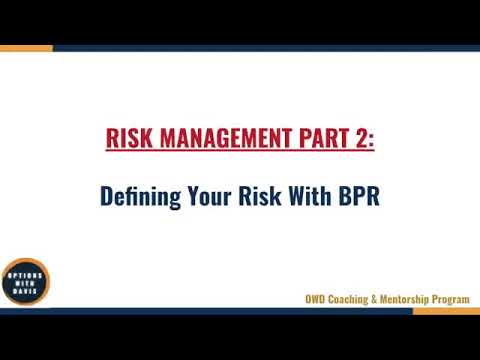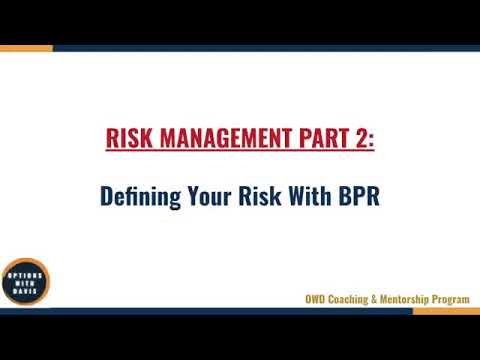In this article, we will be discussing the concept of risk management through the lens of BPR (Buying Power Reduction). BPR refers to the capital that is required to place a trade and is also known as Buying Power Effect. We will explore how BPR is the maximum risk for defined risk strategies, such as spreads, and how it differs for undefined risk strategies, like strangles or short puts. Brokers calculate the BPR to cover potential losses and minimize their own risk. We will also delve into the probability of losses exceeding the BPR, the importance of exiting trades at 21 DTE (Days to Expiration), and the four layers of protection in managing risk for undefined risk strategies. Additionally, we will discuss the potential benefits of using index ETFs for lower risk and how managing risk closely can lead to consistent profits.
1. Risk Management
1.1 Importance of Risk Management
When it comes to trading, risk management is of utmost importance. It is crucial to understand and mitigate potential risks in order to protect your investment and ensure long-term success. By effectively managing risk, you can minimize losses and maximize returns.
1.2 Understanding Risk in Trading
Risk in trading refers to the potential loss or negative outcome of an investment. It is important to note that not all trades carry the same level of risk. Different trading strategies and financial instruments have varying degrees of risk associated with them.
2. Defining Risk with BPR
2.1 What is BPR?
BPR, also known as Buying Power Reduction, is the capital required by brokers to place a trade. It represents the amount of money you need to put up in order to enter into a trade. BPR is calculated based on various factors, such as the size of the trade and the volatility of the underlying asset.
2.2 BPR vs. BPE
BPR is sometimes referred to as BPE, which stands for Buying Power Effect. While these terms are used interchangeably, they essentially mean the same thing – the capital required to place a trade. Understanding the concept of BPR/BPE is essential for managing risk effectively.
2.3 BPR in Defined Risk Strategies
Defined risk strategies, such as spreads, have the BPR as the maximum risk. This means that the amount you put up as BPR is also the maximum amount you can potentially lose in the trade. These strategies offer a level of safety and predetermined risk, making them popular among conservative traders.
2.4 BPR in Undefined Risk Strategies
On the other hand, undefined risk strategies, such as strangles or short puts, do not have the BPR as the maximum risk. With these strategies, the BPR represents the capital required to place the trade, but it does not limit the potential losses. This is important to understand as it means that the actual risk can exceed the initial capital allocated.

3. Calculation of BPR
3.1 How Brokers Calculate BPR
Brokers calculate BPR to cover the majority of possible losses, minimizing their own risk. They take into account various factors, including market volatility, the size of the trade, and the specific trading strategy employed. By calculating the BPR, brokers aim to ensure that the capital allocated by the trader is sufficient to cover potential losses.
3.2 Minimizing Broker’s Risk
It is important to note that brokers have their own interests in mind when calculating BPR. They want to ensure that they do not absorb the client’s losses and maintain their own financial stability. As a trader, it is crucial to understand the broker’s calculations and manage your risk accordingly to protect your own capital.
4. Probability of Loss Exceeding BPR
4.1 Probability in Undefined Risk Strategies
The probability of losses exceeding the BPR in undefined risk strategies is generally low. While it is theoretically possible to lose more than the BPR, the probability of such an event is often unlikely. Brokers calculate the BPR to cover a significant portion of potential losses, minimizing the risk for both parties involved.
4.2 Impact of Exiting at 21 DTE
Exiting a trade at 21 DTE (Days to Expiration) can significantly reduce the probability of loss exceeding the BPR, especially for index ETFs. Studies have shown that for index ETFs, the probability of loss exceeding the BPR is reduced to 0% when exiting at 21 DTE. This time frame allows for a more controlled and predictable outcome, minimizing the risk of substantial losses.
5. Layers of Protection in Undefined Risk Strategies
5.1 First Layer: BPR as a Percentage of Capital Allocation
To manage risk effectively in undefined risk strategies, it is recommended that the BPR should not exceed 5% of your total capital allocation. This ensures that even in the unlikely event of substantial losses, the impact on your overall portfolio is limited.
5.2 Second Layer: Trading Index ETFs
Using index ETFs as a trading instrument provides an additional layer of protection. As mentioned earlier, studies have shown that the probability of loss exceeding the BPR is significantly reduced when trading index ETFs. These instruments offer diversification and stability compared to individual stocks.
5.3 Third Layer: Exiting at 21 DTE
Exiting a trade at 21 DTE, as discussed earlier, further minimizes the risk of loss exceeding the BPR. By setting a predetermined exit point, you can limit your exposure and protect your capital. This practice is particularly effective when trading index ETFs, where the probability of loss exceeding the BPR is reduced to 0%.
5.4 Fourth Layer: Immediate Exit on Max Loss
In the event that the maximum loss hits the BPR amount, it is crucial to exit the trade immediately. This ensures that no single trade exceeds the risk or capital initially allocated. By adhering to this rule, you prevent the possibility of substantial losses and protect your overall portfolio.
6. Potential Loss in the Event of Max Loss
6.1 Understanding Max Loss
Max loss refers to the maximum amount of money you can potentially lose in a trade. In the context of BPR and risk management, it represents the worst-case scenario. It is important to understand that even in the unlikely event of hitting the max loss, the impact on your overall account is limited.
6.2 Limited Risk with 5% Loss to Account
By adhering to the risk management practices outlined in this article, the potential loss in the event of max loss is limited. With the BPR not exceeding 5% of your capital allocation and other layers of protection in place, the overall impact on your account is minimized. It is essential to remember that trading involves risk, but with effective risk management strategies, you can mitigate potential losses and trade with confidence.
